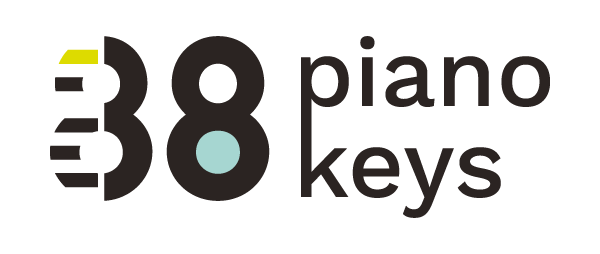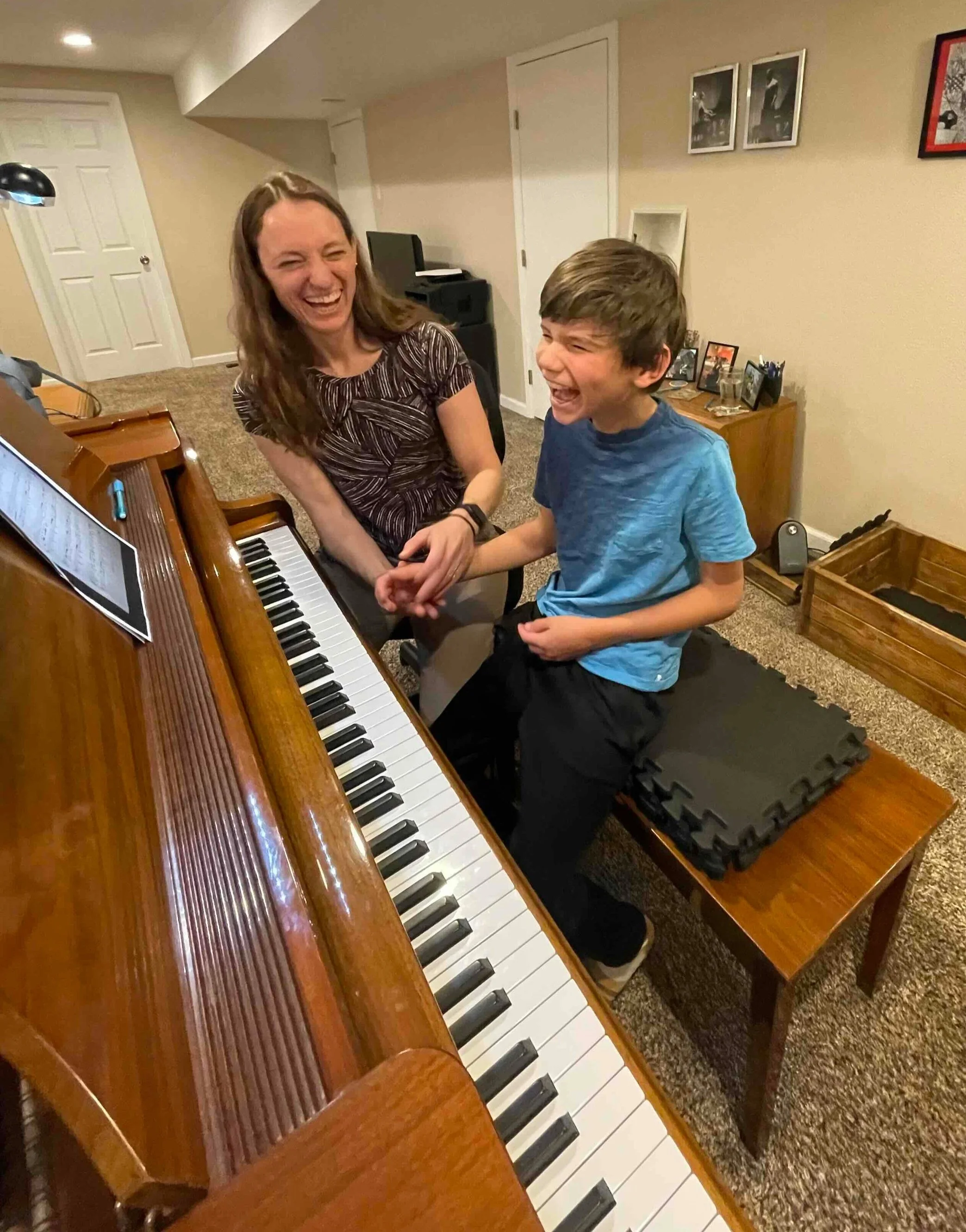The Four Pillars of Learning You Need to Know
Brenna Berman is a Certified Teacher of the Taubman Approach. In other words, if you have technical issues at the piano bench, she’s the one you want to see.
In her special guest blog post below, you’ll catch a glimpse of her brilliance as she shares the connection between the mind and body in achieving a sustainable piano technique.
To learn more about Brenna, listen to this Key Ideas podcast episode #67 where she was my special guest, or better yet, come to her Effortless Artistry workshop this summer!
Knowing how our brains work gives massive boosts to learning effectively, efficiently, and happily.
Everyone knows that when we get nervous, we make more mistakes, but did you also know that nervousness and anxiety block learning?
We are perplexed (and exasperated!) when students make the same errors over and over, even when we know they have practiced. Are they really forgetting that it is F-sharp, not F-natural, again? Probably not. It is actually much more likely that apparent lapses in memory are due to ambiguous, inefficient or faulty coordination in technique. If a note is inconvenient, our body chooses another without us even knowing it!
This one I’m dying to try. If you smell something, say a lavender candle, when you learn your music, did you know you can boost your learning by smelling that same smell while you sleep?
Mind and body are connected in miraculous ways. I used to resist the idea of the mind/body connection. In recent years, I have wondered why we ever divided mind and body in the first place! The mind is a part of the body, literally and completely connected to it!! It makes sense that how we think and feel will impact how we learn and move our bodies.
My work in the Taubman Approach has shown me the importance of understanding movement and coordination in detail. The Taubman work has helped me retrain students of all ages and abilities to play with ease and skill. It has also empowered me to help them recover from and prevent playing-related injuries.
However, over the last 25 years of my career, I have grown increasingly interested in how our brains learn, as well as the impact psychological states can have in the piano studio. I have found they are just as important in helping students improve, learn, and eventually become self-sufficient in their pianism.
The Four Pillars of Learning
In his book, How We Learn, Stanislas Dehaene lays out what he refers to as “The Four Pillars of Learning.” He clearly defines the distinct pillars and uses cognitive science and neurobiology to support each one. Every teacher should have these pillars as part of their toolkit:
⓵ Attention
This might seem obvious, but attention is necessary for learning. Full attention. It is well proven that we can only fully focus our attention on one thing at a time. When we focus our attention, the brain waves related to what we have chosen to focus on are amplified. All other sensory input is suppressed, doomed to be erased forever or, more accurately, never enter into memory in the first place.
The amplified brain signaling during attentive states make their way to the hippocampus, a part of the brain that is necessary for creating new memories. The hippocampus is the processing center that helps move short term memories into long term storage. If we don’t pay attention, we literally cannot learn or remember.
However, paying attention alone does not guarantee that we will remember or learn something, especially in the long term. For that, we need the other pillars.
⓶ Active Engagement
It is starting to become a widespread understanding in education that students must actively engage with their material to be able to learn it and commit it to long term memory. This is why “lecture-only” style classes tend to produce much less long-term learning than classes where the students interact with the material.
The more that students engage and interact with new material, the more they will absorb. This means that students need to think, make mistakes, and interact with the process of learning to play piano. Mindless repeating or simple regurgitating of the information is not enough.
The ways in which piano students can engage with what they are learning are vast. To start, more questions need to be posed to the student, more feedback asked for. Teachers need to pause from information-giving and inquire as to what the student feels or thinks about what they are learning. We need to withhold some answers and have the students hunt for them, using information we have given to guide them to the solutions.
⓷ Error Feedback
Gone are the days where mistakes are to be avoided. In my studio, I celebrate when students make mistakes. Literally I often shout “yay! You made a mistake!” as my students look at me with confusion. I see it as an opportunity for deep learning. I embark on an investigation with them as to why the mistakes occurred. I don’t impose a negative stigma on the mistake, and I am careful not to create fear around making mistakes. We will learn more about why fear of mistakes is a major roadblock on the path to improving learning.
⓸ Consolidation
Colorado Workshop, August 8-10, 2025. Sign up HERE
Well, the fourth pillar is probably my favorite. Sleep. You got it, sleep. It feels a little silly to have this one in a pillar list, but it is so important. No actual learning or long term remembering happens until our brain decides to consolidate the days’ events in sleep.
Sleep is critical for learning. We need enough sleep. We need good quality sleep. But, did you know that we consolidate more of what we learn if we sleep soon after we learn? We can goose learning if we review before bedtime. We can goose learning if we nap after learning! And we can even goose learning by putting elements in the environment where we sleep that are the same as the environment in which we learned them. Yep–get out that lavender candle!
Psychological Safety
It has become more prevalent in work environments that employees are more productive and happy if they experience “psychological safety” at work. This is also true in the piano studio.
Certain emotions and psychological safety interfere with learning. In short, anything that gets our amygdala going, the area of the brain that is dedicated to protecting us and putting us in “fight or flight” mode when our brain perceives danger, hijacks our learning.
Unfortunately, our brain has not evolved enough to tell the difference between a tiger chasing us and getting up on stage to play piano at a recital. Nerves=fear. Fear excites the amygdala. When the brain perceives anything intimidating, scary, or anxiety-provoking, our amygdala is activated. It pulls blood flow and brain waves away from the parts of our brain that learn, and into the part that runs from the tiger.
This means our studios need to be safe. Totally safe. Psychologically safe. Safe to play wrong notes. Safe to play unmusically. Safe.
This one is quite personal to me, because I have had many things in my upbringing and my adulthood that caused me to feel unsafe. Even perfectionism is unsafe. I find that if I’m nurturing in my studio and remind students they are okay if they don’t practice, make mistakes, or play poorly, they are more able, willing, and excited to learn. And they are happier. Isn’t that what we all want?
Brenna is holding a Taubman Approach Workshop and Concert
August 8-10 in Lafayette, Colorado.
I hope you want to learn more! I will be presenting and performing at this year’s Taubman Approach Workshop. Please join us! We will also have Master Teachers Yoriko Fieleke and Elizabeth Grace, as well as Master Taubman pianists Ron Stabinsky and Hugo Bermúdez. Check us out! EffortlessArtistryMusic.com.
Brenna Berman, M.A.
Taubman Approach Certified Master Teacher
The Golandsky Institute, Associate Faculty
Executive Director, Effortless Artistry Music- Taubman Approach






